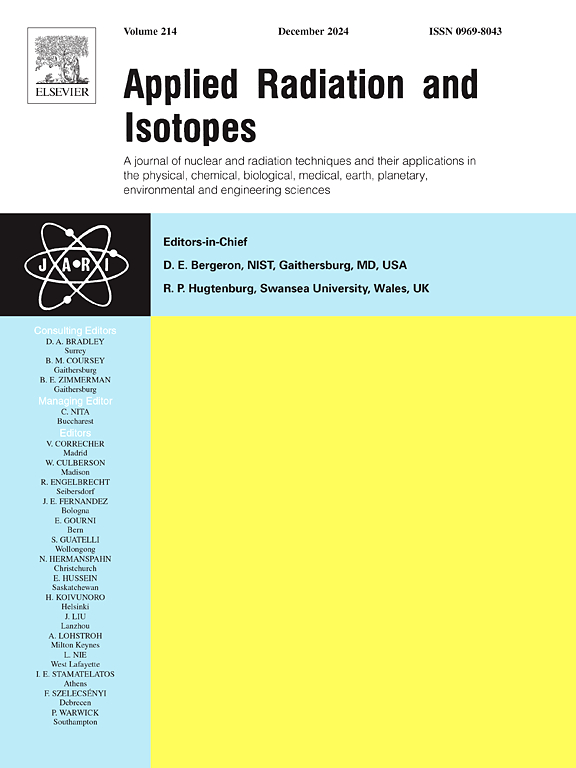Application of cadmium sulfide photoresistor and open-source software for X-ray detection in mammography
IF 1.8
3区 工程技术
Q3 CHEMISTRY, INORGANIC & NUCLEAR
引用次数: 0
Abstract
The extensive use of ionizing radiation in several applications, specially X-rays in medicine, necessitates reliable detection systems for accurate measurement and control. The development of low-cost detectors is crucial to expanding access to these technologies. In this context, some approaches have been developed aiming to construct X-ray detection mechanisms utilizing cadmium sulfide (CdS), a photoconductive semiconductor, as a key material. This study investigates the feasibility of using a low-cost Light Dependent Resistor (LDR) sensor, made of CdS, integrated with a custom-made electronic system, for X-ray detection. The sensor was evaluated under various X-ray beam production parameters, such as tube voltage and exposure time, to assess its responsivity with both industrial and mammography X-ray devices. The detection system monitors variations in the electrical signal by detecting changes in the voltage drop across the LDR when exposed to X-rays. The results demonstrated a linear response at low voltages (up to 55 kVp) and an exponential response at higher voltages. Additionally, the system accurately measured exposure times, with deviations from the reference values of less than 2 %. Despite some experimental limitations, the detection system based on an LDR and Arduino has proven to be an effective tool and could contribute to the advancement of accessible radiation detection technologies.
硫化镉光敏电阻器及开源软件在乳腺x射线检测中的应用
电离辐射在若干应用中的广泛使用,特别是医学中的x射线,需要可靠的检测系统来进行精确的测量和控制。开发低成本探测器对于扩大这些技术的使用至关重要。在此背景下,已经开发了一些方法,旨在利用硫化镉(CdS)作为关键材料构建x射线检测机制。本研究探讨了使用低成本的光相关电阻(LDR)传感器的可行性,该传感器由cd制成,与定制的电子系统集成,用于x射线检测。该传感器在各种x射线束产生参数(如管电压和暴露时间)下进行了评估,以评估其对工业和乳房x射线设备的响应性。当暴露于x射线时,检测系统通过检测LDR上电压降的变化来监测电信号的变化。结果表明,在低电压(高达55 kVp)下呈线性响应,在高电压下呈指数响应。此外,该系统准确地测量了曝光时间,与参考值的偏差小于2%。尽管存在一些实验限制,但基于LDR和Arduino的检测系统已被证明是一种有效的工具,可以为无障碍辐射检测技术的进步做出贡献。
本文章由计算机程序翻译,如有差异,请以英文原文为准。
求助全文
约1分钟内获得全文
求助全文
来源期刊

Applied Radiation and Isotopes
工程技术-核科学技术
CiteScore
3.00
自引率
12.50%
发文量
406
审稿时长
13.5 months
期刊介绍:
Applied Radiation and Isotopes provides a high quality medium for the publication of substantial, original and scientific and technological papers on the development and peaceful application of nuclear, radiation and radionuclide techniques in chemistry, physics, biochemistry, biology, medicine, security, engineering and in the earth, planetary and environmental sciences, all including dosimetry. Nuclear techniques are defined in the broadest sense and both experimental and theoretical papers are welcome. They include the development and use of α- and β-particles, X-rays and γ-rays, neutrons and other nuclear particles and radiations from all sources, including radionuclides, synchrotron sources, cyclotrons and reactors and from the natural environment.
The journal aims to publish papers with significance to an international audience, containing substantial novelty and scientific impact. The Editors reserve the rights to reject, with or without external review, papers that do not meet these criteria.
Papers dealing with radiation processing, i.e., where radiation is used to bring about a biological, chemical or physical change in a material, should be directed to our sister journal Radiation Physics and Chemistry.
 求助内容:
求助内容: 应助结果提醒方式:
应助结果提醒方式:


